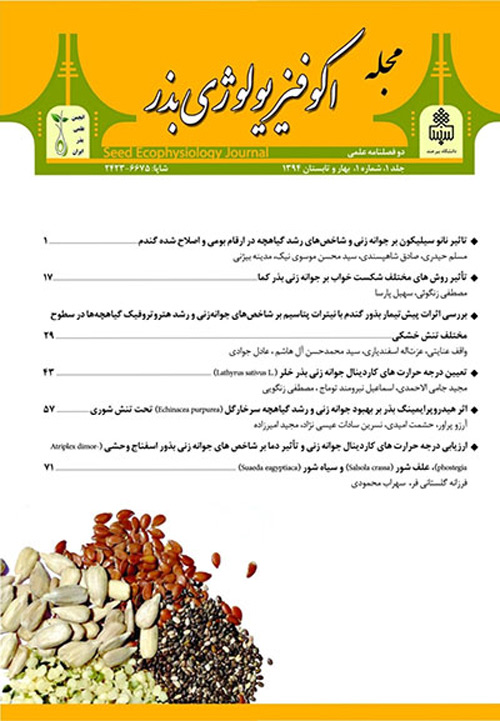Effect of Phosphate Solubilizing Bacteria and Mycorrhizal fungi on nutrient elements content of seed in two wheat cultivars under dry land conditions
Beneficial free-living rhizobacteria, which have been shown to improve plant health or increase yield, are usually referred to as plant growth-promoting rhizobacteria (PGPR). Mycorrhiza, which is a symbiotic fungus, has been under researches for more than a century. Inoculation of plant roots with arbuscular mycorrhizal (AM) fungi may be effective in improving crop production under drought conditions. Improved productivity of AM plants was attributed to enhanced uptake of immobile nutrients such as phosphorus, zinc and copper. In addition, other factors associated with AM colonization may influence plant resistance to drought. Therefore the main of this study was to effect of phosphate solubilizing bacteria and Mycorrhizal fungi on yield, yield components and its associated in two dryland wheat cultivars.
An experiment was carried out in factorial arrangement using randomized complete block design with three replications at Agricultural Research Station of Ilam University and Sarableh Agricultural and Research, Recources Center during 2013-2014 cropping season. Experiment factors consisted of two dry land wheat cultivars (Keras Sablan and Saji) and fertilizer sources treatment including of 1- without application of phosphorious chemical fertilizer, 2- 50 kg/ha P, 3- p. putida, 4- G.mosseae, 5- p.putida + G.mosseae, 6- p.putida + G.mosseae +25 kg/ha P, 7- p.putida + 25 kg/ha P and 8- G.mosseae +25 kg/ha P. At full maturity, Seed nutrients such as nitrogen, phosphorous, potassium, Zn, Mg, Mn, Fe and Cu were recorded using a sample plants from the middle ridges of each plot. The data were analyzed statistically by SAS program and the data means were compared by LSD test.
Results indicated that interaction effect between cultivar ×fertilizer sources had significant effect on nitrogen, phosphorous, potassium, Zn, Mg, Mn, Fe in seed wheat. Using of bio-fertilizer had positive and significant effect total studied traits in two dryland wheat under dry land condition. The highest zinc element in seed was obtained from Saji cultivar and using p.putida + G.mosseae +25 kg/ha P and the least of it was Keras Sabalan cultivar in control treatment, which increased to 49.7% in the zinc element in the seed. The highest amount of manganese in seed was from Saji cultivar in the application of p.putida + G.mosseae +25 kg/ha P and the least manganese obtained from Keras Sabalan cultivar in control treatment, which increased 53.3% in the manganese element in the seed. The highest iron element in the seed belonged to Saji cultivar and using of p.putida + G.mosseae +25 kg/ha P and the lowest from Keras Sabalan cultivar in control treatment, which caused an increase 97.2% in iron element in grain. The highest magnesium content in the seed was obtained from Saji cultivar and using of p.putida + G.mosseae +25 kg/ha P and the lowest from Keras Sabalan cultivar in control treatment, which increased 39.1% in the magnesium element in the seed. The highest nitrogen content in the seed was from Sagi cultivar in the application of p.putida + G.mosseae +25 kg/ha P and the lowest nitrogen content indicated in Keras Sabalan cultivar in the control treatment, which caused an increase of 21.5% in nitrogen in grain. The highest P content in the seeds was from Saji cultivar and the application of p.putida + G.mosseae +25 kg/ha P and the least P content was cultivar Keras Sabalan in control treatment, which increased 66.1% in phosphorus in grain. The highest element of potassium in seed was obtained Saji cultivar and using of p.putida + G.mosseae +25 kg/ha P and the least Pseudomonas potassium indicated in Keras Sabalan cultivar in control treatment, which caused an increase 64.8% of potassium content was in the seed. There was significant different between cultivars to response of Using of phosphate solubilizing bacteria and mycorrhizal fungi, so that Sji cultivars had the best response to mycorrhizal fungi.
In this study indicated that GM and PSB had positive affect on seed quality and seed nutrients had the better status in presence of inoculationwithGM and PSB. Application of GM and PSB with fertilizer levels significantly increased the macro and micro elements uptake thad was recorded from Saji Cultivar × GM + 25 kg/ha P. The decrease in available N, P, K, and Fe, Mn, Mg, Ze status of seed was recorded in control where no fertilizer (control treatment). The increased uptake of the nutrients was due to added supply of nutrient and well developed root system resulting in better absorption of water and nutrient. According to the results, the use of GM and PSB cause root development and provide conditions for the absorption of nutrients. In this study, GM and PSB through the development of mechanisms such as root growth have increased the absorption of nutrients and the development of photosynthetic surfaces and the plant produced materials for the development of their organs. Finally, the nutrients in the seeds increased.
- حق عضویت دریافتی صرف حمایت از نشریات عضو و نگهداری، تکمیل و توسعه مگیران میشود.
- پرداخت حق اشتراک و دانلود مقالات اجازه بازنشر آن در سایر رسانههای چاپی و دیجیتال را به کاربر نمیدهد.


